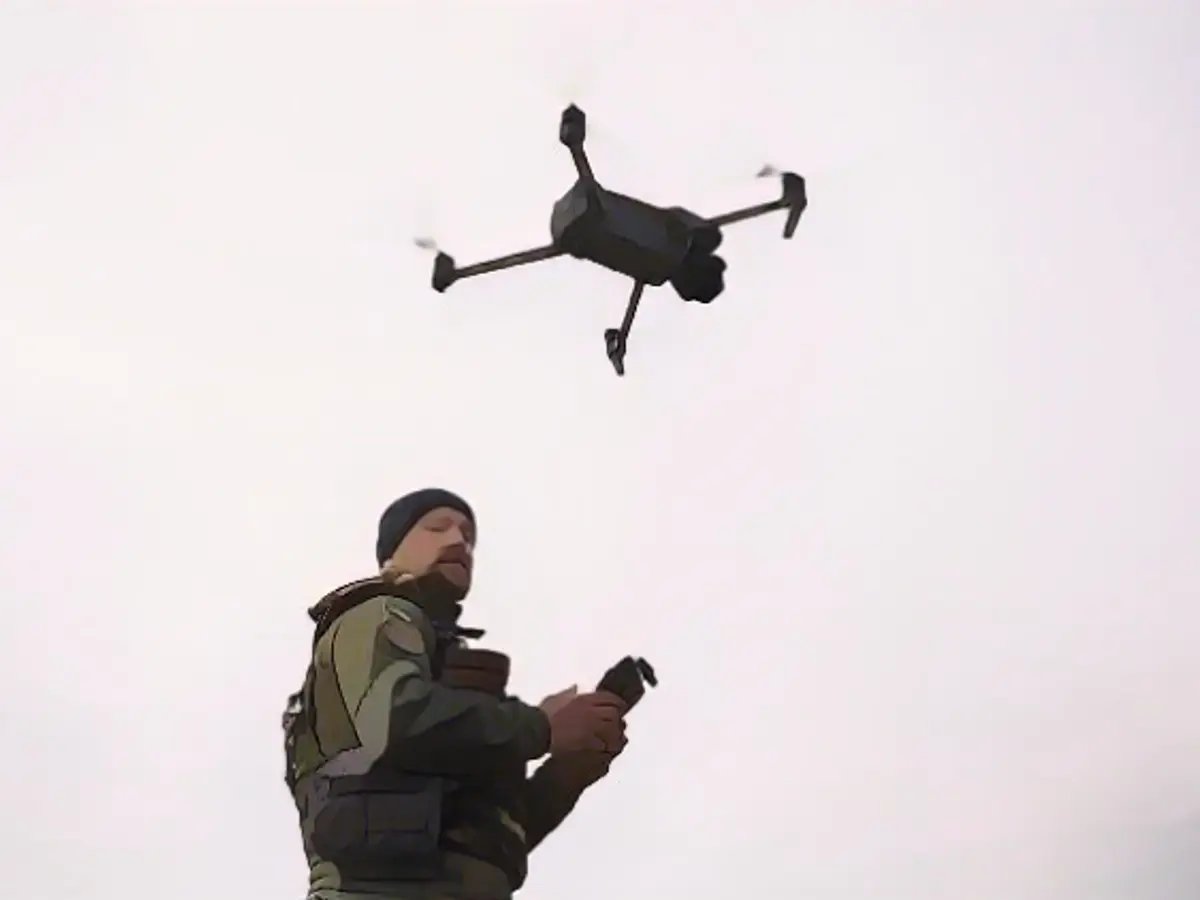Ukrainians are "beset by swarms of drones"
Initially, Ukraine achieved spectacular successes with Western cruise missiles. However, these are becoming rarer as Russia is becoming increasingly successful in disabling the precision weapons. In addition, they produce many times the number of Ukrainian drones. Military expert Markus Reisner explains the consequences of this in an interview with ntv.de.
ntv: For some time now, reports from the Ukrainian front have painted very different pictures: In the east around Donetsk, Russia has the initiative and is attacking, while in the south near Kherson, the Ukrainians are on the offensive. How is that connected?
Reisner: Around mid-October, the Russians obviously began an offensive operation, roughly in the area between Kupjansk and Avdiivka. In addition to both cities, Svatove is another hotspot. Avdiivka is threatened with encirclement. The Russians are being very ruthless with their own forces here. They are constantly trying to attack with small combat groups, especially in the area south of Kupjansk to Svatove. The Russians are trying to encircle Avdiivka in a pincer movement. Drone footage from the Ukrainian side shows that the Russian troops are suffering very heavy losses, but are not giving in.
How well can Avdiivka hold its ground?
A comparison with Bachmut comes to mind here. There is only one efficient supply line left through which the Ukrainian troops can bring goods from the west into the cauldron. A video has emerged in which the 110th Brigade, which is defending the encirclement with several thousand men, asks for support because otherwise the city cannot be held.

Will they get it?
Ukraine has tried to deploy two brigades - the 47th mechanized brigade equipped with Leopard and Bradley tanks to counter the threat of a pincer movement from the north-west, and the first armoured brigade. Both were to launch counterattacks to prevent the Russian side from closing in. A little to the north, another brigade also asks for support via video because the pressure from the Russian side is so great. However, if we turn our gaze from the east to the south and the Dnieper, we see a different situation further south. Ukraine is on the offensive here.
Why are the troops managing this there?
They have very intelligently begun to prevent the use of Russian drones, at least locally, by using their own jamming equipment. This has made it possible for Ukraine to bring significant forces to the other side of the river in recent weeks, which has led to approximately one battalion, i.e. several hundred Ukrainian soldiers, now being deployed there. The problem, however, is that the Russians are attacking this potential bridgehead from a safe distance, primarily through the use of FAB glide bombs. And that brings us from the tactical to the operational level.
What do we see there? What objective are the troops pursuing?
Both sides are trying to force each other to deploy reserves. The Russians want the Ukrainian troops to use up their precious reserves in the north-east. By crossing the river in the south, Ukraine is trying to force the Russians to move precious reserves from the northeast to the south so that these forces are no longer available for offensive operations.
That sounds as if the situation is more or less balanced, but that's probably not true, is it?
The Ukrainians' problem is that the Russians are using the aforementioned FAB glide bombs more and more successfully in the air component. Every day, videos show how they attack Ukrainian staging areas with these bombs. However, as the glide bombs fly long distances, Russian fighter jets can fire them from a safe distance, beyond the range of Ukrainian air defenses. Ukraine, on the other hand, is now having increasing problems using its precision weapons supplied from the West.
That is why there are now fewer reports of spectacular deployments of Storm Shadow, SCALP or ATACMS?
Unfortunately, it must be assumed that many of these systems are now being jammed by the Russian side, i.e. their targeting has been disrupted and they have been brought down. Even more devastating: the Russians are now also able to jam around three quarters of the Ukrainian drones. As a result, the Ukrainians can no longer use the "First Person View" drone system they invented as effectively as in previous months.
Very briefly: "First Person View" means that the person controlling the drone has a perspective as if they were sitting in the drone?
Exactly. This technological innovation was developed within the drone scene. A few geeks have developed drones that are linked to VR goggles and then steered using virtual reality as if you were the pilot in the drone. These people have flown spectacular races through chimneys, for example.
Have the Ukrainians copied the system?
They have adapted it, yes, in their small backyard production facilities. They take this drone and the control system, but arm it with explosives, for example with the warhead of a tank missile. Then they steer this drone specifically into a bunker. Or into a motor vehicle. Ukraine has used this very innovatively on the battlefield, but still builds the devices on a small industrial scale because it no longer has an extensive military-industrial complex. Russia is different: the Russians have now also started to build these "first person view" drones, but in industrial production. They are flooding the battlefield with their drone systems and jamming those in Ukraine at the same time.
Particularly fatal because drones now play such a major role?
Thanks to the use of drones, each side can see what the other is doing. But the Russians are increasingly able to deploy their jamming systems across the entire front and put Ukrainian drones out of action. Unlike Russia, Ukraine has very limited resources. It has now tried to compress its jammers in the south and thereby achieve superiority in the electromagnetic field. This is not possible in the north-east.
You mentioned that the cruise missiles and ATACMS are now also being jammed. These are all precision weapons supplied by the West. Where has Russia suddenly acquired these capabilities?
The Storm Shadow or SCALP cruise missiles have in common with the converted bombs such as ATACMS that they achieve their precision by means of GPS signals. There were initial successes after delivery, but then this waned because the Russians were increasingly able to jam the GPS seeker heads. They already had great capabilities in the electromagnetic field during the Cold War and are still very well positioned there. Although Ukraine has had successes from time to time, just recently a ship was hit again, a large number of cruise missiles were launched and apparently only one actually hit its target.
Does this sound like another argument in favor of Germany delivering the Taurus as soon as possible? After all, it was specially designed at the time to evade Russian air defense.
The Taurus manufacturer says that this cruise missile is particularly resistant to interference attempts in the electromagnetic field. Whether this proves to be true would have to be determined in actual tests. And then it would again take some time for the Russians to adapt. This is always the case when the first systems crash and the enemy can analyze them: "Aha, he's working on this frequency..." For this reason, the USA is often somewhat reluctant to supply weapons or - as in the case of the Abrams tank - builds in functions beforehand because the Pentagon does not want the Russian side to be able to study the weapons.
But has any knowledge been gained about Russian weapons?
One of the first Russian Pantsir air defense systems, which has a reputation for being able to successfully intercept Himars, was brought from the Ukraine to Ramstein and from there to the USA to be examined.
It sounds as if it is perhaps less important at the moment whether you have 12 or 15 Leopard tanks on the battlefield, but the more relevant question is: Who controls the electromagnetic field and can disable the enemy's weapons?
This creates the biggest problem for the Ukrainian troops at the moment: the moment they start moving, they are immediately beset by swarms of drones. And that has to be prevented. If you now look at the future course of the conflict from a strategic perspective, then the aim must be to consolidate Ukraine over the winter. The focus of the support provided by the West should now be on air defense, as this will enable Ukraine to counter a possible new strategic air campaign by the Russians. Only if this succeeds can Ukraine maintain its critical infrastructure, reorganize itself in parallel and then go on the offensive again in the spring.
Frauke Niemeyer spoke with Markus Reisner
Given the current situation, how is Ukraine dealing with the swarms of drones used by Russia in their attacks?
To combat the drone swarms, Ukraine has started using its own jamming equipment to disrupt the Russian drones' communication signals. This has allowed them to deploy significant forces on the other side of the river, resulting in Ukrainian troops being present in the area south of the Dnieper.
In light of Russia's increasing use of FAB glide bombs and jamming of Ukrainian drones, what is the future course of the conflict from a strategic perspective?
From a strategic perspective, the main focus for Ukraine should be to consolidate their position over the winter, with the primary support from the West focusing on air defense. By strengthening their missile defense systems, Ukraine can counter any potential strategic air campaign by Russia. Only then can they reorganize and mount an offensive when the conditions are more favorable in the spring.
Source: www.ntv.de








